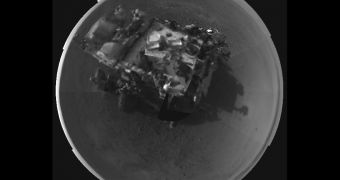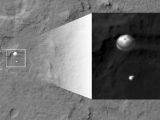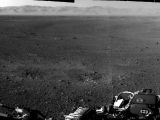Three days after landing on Mars, NASA's Curiosity rover has activated its navigation cameras, or Navcams, and has already sent home a new series of images, including a 360-degree panorama that created its first self-portrait.
The rover sent images that show its deck from above, along with a set of low-resolution thumbnails that provide a 360-degree view of its new home in Gale Crater.
Along with these, the rover sent back to Earth two, higher-resolution Navcams images that deliver a more detailed view of the planet’s surface next to the Curiosity.
"These Navcam images indicate that our powered descent stage did more than give us a great ride, it gave our science team an amazing freebie," said John Grotzinger, project scientist for the mission from the California Institute of Technology in Pasadena.
"The thrust from the rockets actually dug a one-and-a-half-foot-long [0.5-meter] trench in the surface. It appears we can see Martian bedrock on the bottom. Its depth below the surface is valuable data we can use going forward."
In addition to these images, NASA got hold of photos from the Context Camera, or CTX, aboard its Mars Reconnaissance Orbiter, which show the final resting point of the six, 55-pound (25-kilogram) entry ballast masses.
These masses have landed on the Red Planet at high speed and are resting about 7.5 miles (12 kilometers) from Curiosity's location.
Also on Wednesday, the team of scientists managed to deploy the 3.6 foot-tall (1.1-meter) camera mast aboard Curiosity, and also activated rover's Radiation Assessment Detector, which has already sent home the first batch of data.
The Curiosity rover has 10 science instruments that feature a total mass 15 times as large as the payloads present on NASA's Mars rovers Spirit and Opportunity. Some of these are the first of their kind to be sent to the planet.
Given the larger scientific payload, Curiosity is twice as long and five times as heavy as Spirit or Opportunity.
“Curiosity will use a drill and scoop, which are located at the end of its robotic arm, to gather soil and powdered samples of rock interiors, then sieve and parcel out these samples into the rover's analytical laboratory instruments,” NASA explains.

 14 DAY TRIAL //
14 DAY TRIAL // 

